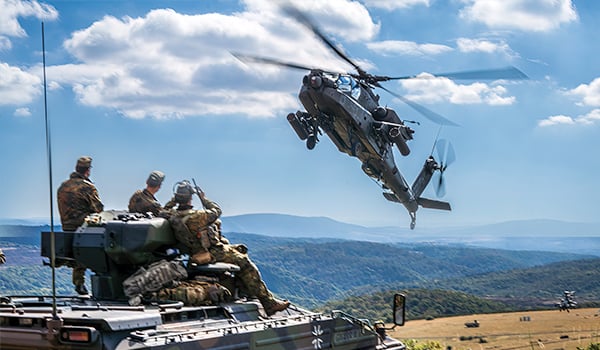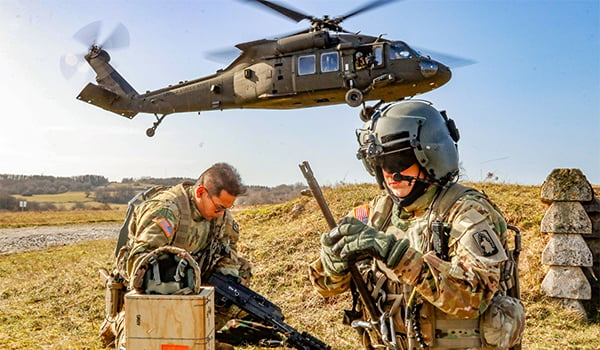
Army Aviation Branch Chief’s Corner / By MG David J. Francis: I would like to start this issue with a huge “thank you” to MG (Ret.) Jeff Schloesser for his steadfast leadership of AAAA over the course of a world-wide pandemic! He and the AAAA team left no stone unturned mitigating the threat of COVID 19 at AAAA events.

U.S. ARMY PHOTO BY MAJ ROBERT FELLINGHAM
While the Summit did not come to fruition this year, they demonstrated the gold standard of innovation and leadership that will undoubtedly result in future successful events for all stakeholders. I would also like to welcome MG (Ret.) Tim Crosby to the helm of AAAA. He brings a wealth of Army Aviation and industry experience that will serve us all well into the future! Thank you, gentlemen, for your continued selfless service to AAAA and the Aviation Branch!
CSM Wilson, CW5 Koziol, and I are incredibly proud of Army Aviation and what all of you accomplished over this difficult year. The Army’s People First Strategy across all Components could not be more relevant as the Leaders and Soldiers of Army Aviation, despite the pandemic, remains 85% committed through rotational forces, theater and ready requirements at home and abroad, combat training center (CTC) rotations, fielding, and modernization. You tackled a record fire season, the most active hurricane/tropical storm season on record, and a pandemic that challenged every aspect of our military and society. Aviation leadership across all COMPOs continues to execute a very demanding mission set with over 14K Soldiers deployed across more than 12 countries providing support to ground forces, partners, and agencies daily. Throughout this time, you maintained the sacred trust we enjoy with our ground force commanders, the very reason we exist!

An AH-64 Apache from Co. A, 1-3 Attack Battalion make a low pass over German joint terminal attack controller instructors and members of the Franco-German Brigade at the end of a successful training iteration on Sep. 9, 2020 at Baumholder Training Area, Germany. During this exercise 12th Combat Aviation Brigade supported the German artillery school training of its Joint Terminal Attack Controllers by providing aerial live fire controlled by German observers. / U.S. ARMY PHOTO BY MAJ ROBERT FELLINGHAM
Despite the pandemic, the Aviation Enterprise is working hard to prepare the Branch to execute Large Scale Combat Operations (LSCO) across all Domains. The challenges we face require the teamwork of U.S. Army Aviation Center of Excellence (USAACE), Aviation and Missile Command (AMCOM), Program Executive Office Aviation (PEO-Avn), Future Vertical Lift Cross-Functional Team (FVL CFT), Army G-3 Aviation (DAMO-AV), Army Special Operations Aviation Command (ARSOAC), and the Technology Applications Program Office (TAPO) as we work issues across the Branch and the Total Aviation Force.
Doctrine
Our capstone doctrinal manual, FM 3.04, Aviation Operations, was published in 2019 and incorporates many aspects of multi-domain operations (MDO). We remain in stride with the Army as FM 3.0 is currently under revision turning the concept of MDO 2028 into doctrine. In addition to our FMs, we published and revised SOPs for standardization and maintenance along with training support packages for terrain flight and radar threats. Our doctrinal foundation is essential to moving forward as a maneuver force.
Organization
We continue to optimize our effectiveness through organizational refinements and updated organizational design. We are synchronizing our organizational changes with the Regionally Aligned Readiness and Modernization Model (ReARMM) to ensure we transform with the Army into a multi-domain capable force ready for competition, crisis, or conflict. Our organizational designs will maximize enduring and future capability to rapidly converge effects at the time and place of our choosing to present multiple dilemmas to our adversaries. This design will also provide the right capability to our Division commanders and set the conditions for introducing Future Vertical Lift (FVL) capabilities.
Training
The transition from counter insurgency (COIN) to LSCO requires training at echelon from commanders and staffs down to each aircrew. Effective training for our aviators must be commander-driven, rigorous, realistic, and under the conditions that units expect to operate in during combat. We are changing our flight profiles from the COIN altitudes to low-level terrain flight that will keep us decisive and survivable in the lower tier of the air domain. The dissemination of the Terrain Flight Training Support Package is already providing value to commanders and subordinates as a framework to deliberately plan and execute safe and effective tactical missions at terrain flight altitudes. This summer, five combat aviation brigades (CABs) will implement “pilot” courses for the Unit Trainer/Evaluator program. Developing and employing Unit Trainer/Evaluators focuses current instructors on tactics, distributes the training workload, and allows commanders to create more trainers and get their IPs out of the traffic pattern. By 1 May this year, all Aviation units will be complete with the implementation of the Emergency Response Method to change the method and understanding of how our aviators can more effectively and safely handle emergencies, especially as we lower our flight profile to train for a LSCO environment.
Materiel
Incredible transformational capability is under development with the hard work of the FVL CFT, PEO Aviation, the Aviation Enterprise, and industry. The team is developing transformational capabilities that fundamentally change how we will fight and increase our reach, survivability, lethality, and sustainability for future operations… and in record time! The Joint Multi-Role Technical Demonstrators inform these efforts and demonstrate the required capabilities for FVL. These risk reduction efforts will result in the most informed requirements we have ever developed in Aviation and the very best end-state for our Aviators in the force that will employ them.
The Future Attack Reconnaissance Aircraft (FARA) and Future Long Range Assault Aircraft (FLRAA), teamed with Air Launched Effects will operate from positions of relative sanctuary, conducting in-depth reconnaissance to penetrate then dis-integrate Integrated Air Defense Systems and open windows for Joint Combined Arms Maneuver to exploit. Long Range Precision Munitions will engage three times the current range to destroy IADS-high payoff targets. FLRAA will supplement the enduring UH-60 fleet with greater speed and range, providing commanders with options to conduct air assaults or air movements at distance, insert key reconnaissance and surveillance assets, secure key terrain and facilities, fix or block enemy fires, and provide sustainment. The Improved Turbine Engine will power the FARA, UH-60 and, AH-64, increasing horsepower, lift capability, endurance, and reliability. The Modular Open Sources Approach (MOSA) design provides affordable and rapidly tailorable mission equipment packages via open systems architectures, allowing efficient survivability and detection systems. Our Future Tactical Unmanned Aircraft System (FTUAS) will enable Soldiers to launch these systems with little or no runway requirement and control or transfer the system easily with a tablet. As we add FVL aircraft and capabilities to the force, we will develop an organization capable of manning, training, and equipping newly fielded units and their systems. This organization must be comprehensive and capable of providing scenarios to meet the demands of an MDO environment. Many of us remember this as a “21st CAV” like structure to field our enduring aircraft.
Leader Development
Leader development is critical as we are currently training the lieutenants, warrant officers, and privates that will be the S3/XOs, standardization pilots and platoon sergeants of our FVL formations. Army Aviation leader development is a deliberate, continuous, and progressive process designed to prepare leaders to fight in a LSCO environment. We are shifting our professional military education (PME) from broadening to deepening to sharpen the tactical skills of our leaders. We are optimizing our education and training to hone the warrant officer’s edge and prepare them for LSCO by removing unnecessary staff officer requirements and emphasizing MOS-specific training as part of their career path. Revamping the Instructor Pilot Course to a Weapons Tactics Instructor Course is just one initiative to transform our aviators and leaders. The revisions to our Aviation Captain’s Career Course (AVCCC) curriculum incorporate LSCO centric scenarios, providing future leaders opportunities to engage and understand aviation as a maneuver force.
Our quarterly Aviation Warfighting Forum is a collaborative venue for corps and division commanders and aviation leaders to discuss trends in warfighting, innovation at both home station and the CTCs, and the testing of emerging technologies that include munitions, sensors, and survivability equipment. Additionally, through personnel initiatives and incentives, we are increasing our aviators’ retention levels and retaining our force’s tactical knowledge base.
People
Last year we saw the first increase in Aviation Career Incentive pay in 20 years. Adjusting this incentive and targeting our bonuses helps retain our experience, provide depth and trainers across the operational force, and reduce personnel tempo. We are increasing the throughput at Fort Rucker to fill cockpits in the operating force and working with Human Resources Command to enhance assignment policies to more clearly manage our critical readiness generators – instructor pilots and maintenance test pilots.
Facilities
Our combat developers are undertaking a full review of our current facilities to ensure we meet enduring and future requirements for FVL platforms. Our future platforms will be very network-centric for maintenance, mission planning, mission preparation, and communication with other joint systems. Our maintenance facilities will require cutting-edge troubleshooting hardware, portals, and connections.
Modernizing and transforming our training will require changes to the Army’s polices and with members across the Joint Force. We anticipate that the FVL platforms’ technological advancements will require unique training areas, nuances to frequency management, and airspace considerations for significant unmanned systems’ employment.
Conclusion
This is an exciting time to be a part of Army Aviation! We are undergoing the most extensive modernization and training adjustment we have experienced in 40 years. Our Branch remains strong, resilient, and ready to support any mission for the Army. Our enterprise is equally strong through the constant collaboration to inform and solidify our requirements and streamline our messaging across the Army and DOD. We must continue our cross-talk to sustain readiness and pursue our modernization needs in order to fight and win against revisionist powers and peer competitors.
I would also like to thank our incredible families. They provide the love and support that enables us to do the vital work we are undertaking. Thanks to all of you and for your service and sacrifice as well.
Finally, please keep all of our Aviators deployed around the world in your thoughts and prayers.
Above the Best!
MG David J. Francis is the Army Aviation branch chief and commander of the U.S. Army Aviation Center of Excellence and Fort Rucker, AL.








